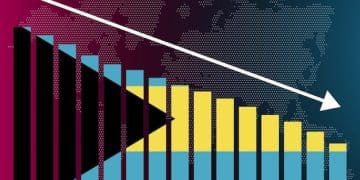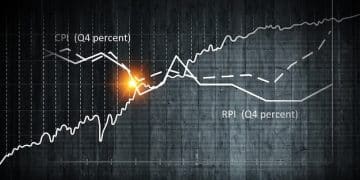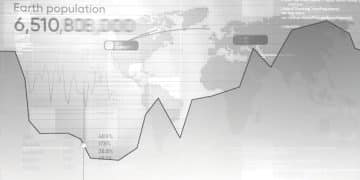Fed Rate Hike 2025? Expert Analysis & Predictions
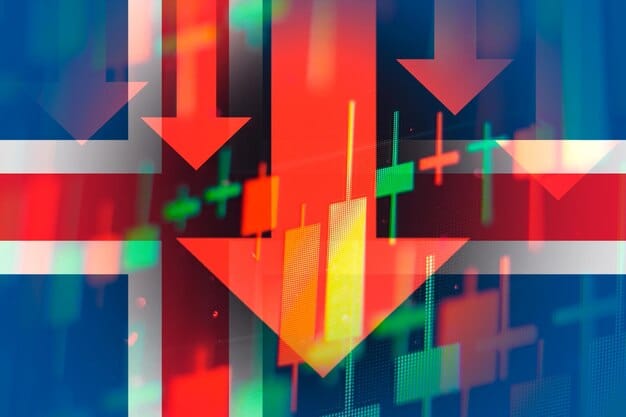
The Federal Reserve’s potential interest rate decisions in early 2025 hinge on various economic indicators, including inflation trends, labor market health, and global economic stability, making any definitive prediction complex and subject to ongoing data analysis and expert consensus.
The question of whether Will the Fed Raise Interest Rates Again in Early 2025? Expert Analysis and Predictions is at the forefront of financial discussions, impacting everything from mortgage rates to investment strategies. Understanding the Federal Reserve’s complex decision-making process requires a deep dive into economic indicators, historical precedents, and the diverse perspectives of leading financial experts.
The Federal Reserve’s Mandate and Current Economic Climate
The Federal Reserve, often referred to as “the Fed,” operates under a dual mandate from Congress: to achieve maximum employment and maintain price stability. These two goals are often intertwined, and the Fed’s primary tool for achieving them is adjusting the federal funds rate, which influences other interest rates throughout the economy. As we approach early 2025, the economic climate presents a complex picture that will heavily influence the Fed’s next moves.
Inflationary Pressures and Price Stability
Inflation has been a central concern for the Fed in recent years. While it has shown signs of moderating, the path to the Fed’s 2% target remains under close scrutiny. Key data points such as the Consumer Price Index (CPI) and the Personal Consumption Expenditures (PCE) index are meticulously analyzed. Sustained downward trends in these indices could provide the Fed with the flexibility to hold rates steady or even consider cuts, whereas a resurgence of inflationary pressures would bolster the case for further hikes.
Labor Market Dynamics and Employment Goals
The labor market’s health is another critical component. A strong labor market, characterized by low unemployment rates and consistent wage growth, typically indicates a robust economy. However, an overheating labor market can contribute to inflationary pressures. The Fed seeks a balance: full employment without creating wage-price spirals. Factors like job openings, unemployment claims, and labor force participation rates will be closely watched for early 2025.
Geopolitical Factors and Global Economic Stability
Beyond domestic concerns, global economic dynamics and geopolitical events can significantly impact the Fed’s decisions. International trade relations, supply chain disruptions, energy prices, and geopolitical conflicts can introduce external inflationary pressures or create economic uncertainties that influence the Fed’s outlook. The interconnectedness of global markets means that events far from U.S. borders can ripple through the domestic economy, potentially altering interest rate trajectories.
In conclusion, the Fed’s upcoming decisions are not made in a vacuum but are carefully calibrated responses to a multifaceted economic environment. Their primary challenge will be navigating persistent inflationary threats while ensuring the labor market remains strong and resilient against global headwinds.
Analyzing Current Economic Indicators for 2025
Forecasting the Federal Reserve’s interest rate policy for early 2025 necessitates a meticulous examination of the most recent economic indicators and their projected trajectories. These data points serve as critical signposts for the Fed, guiding their assessments of economic health and inflationary pressures. Understanding these indicators provides valuable insight into the central bank’s potential next steps.
Inflation Trends: CPI, PCE, and Core Metrics
The Consumer Price Index (CPI) and the Personal Consumption Expenditures (PCE) price index are the two primary gauges of inflation. The Fed often prefers the PCE, particularly the “core PCE,” which excludes volatile food and energy prices, as a more accurate measure of underlying inflation.
* CPI Data: Provides a monthly snapshot of consumer prices for a basket of goods and services. A slowdown in the monthly and year-over-year CPI figures would suggest disinflationary trends are gaining traction.
* PCE Data: Broader in scope than CPI, it reflects changes in the prices of goods and services purchased by consumers. Persistent readings below or near the Fed’s 2% target for core PCE would signal success in bringing inflation under control.
* Inflation Expectations: The Fed also monitors various surveys of inflation expectations, as these can be self-fulfilling prophecies. If businesses and consumers expect inflation to remain high, they may price goods and services accordingly, perpetuating the cycle.
Labor Market Strength: Unemployment Rates and Wage Growth
The strength of the labor market is a cornerstone of the Fed’s dual mandate. A robust jobs report can indicate healthy economic activity, but rapid wage growth can also fuel inflation.
* Unemployment Rate: Measures the percentage of the labor force that is unemployed but actively seeking work. A sustained low unemployment rate, particularly below the Fed’s estimated “natural rate,” could suggest overheating.
* Job Openings and Labor Turnover Survey (JOLTS): Provides insights into labor demand and churn. A significant decline in job openings, coupled with rising unemployment, could signal an economic slowdown reducing the need for higher rates.
* Wage Growth: While beneficial for workers, excessive wage growth that outpaces productivity gains can contribute to inflationary pressures. The Fed monitors average hourly earnings closely.
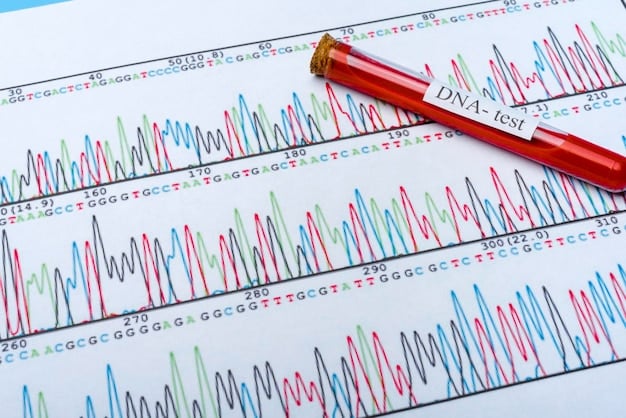
GDP Growth and Consumer Spending Habits
Gross Domestic Product (GDP) provides a comprehensive measure of economic output, while consumer spending is a significant driver of that output. Weak GDP growth or a significant slowdown in consumer spending could indicate an economy losing momentum, potentially requiring less restrictive monetary policy. On the contrary, robust GDP and strong consumer confidence might allow the Fed to maintain a tighter stance if inflation remains a concern. The retail sales data and consumer confidence indices are key insights into these dynamics.
The collective behavior of these economic indicators will weigh heavily on the Fed’s deliberations as 2024 concludes and 2025 begins. Each data release contributes to the evolving economic narrative that the Fed will interpret to make its critical interest rate decisions.
Expert Forecasts for Early 2025 Interest Rates
Economists, financial analysts, and market strategists widely dissect the Federal Reserve’s potential actions, offering diverse forecasts for interest rates in early 2025. These predictions are shaped by their unique interpretations of current data, anticipated future economic shifts, and historical Fed behavior. Understanding this spectrum of expert opinion is crucial for gaining a comprehensive view of the landscape.
Consensus View: Holding Steady or Gradual Cuts
As of recent discussions, a growing consensus among many economists leans towards the Fed either holding interest rates steady or initiating a series of gradual rate cuts in early 2025, rather than another hike. This outlook is primarily driven by:
* **Slowing Inflation:** Evidence of persistent disinflationary trends and a return to the Fed’s 2% target range.
* **Balancing Risks:** A desire by the Fed to avoid overtightening and triggering an unnecessary recession, especially if inflation is being contained.
* **Data Dependency:** The expressed commitment by Fed officials to remain data-dependent, implying flexibility to adjust policy as new information emerges.
Bearish Outlook: Continued Vigilance and Potential Hikes
A more hawkish segment of experts, though perhaps a minority, still foresees the possibility of further rate hikes or at least a prolonged period of high rates well into 2025. Their arguments often rest on:
* **Stubborn Core Inflation:** Concerns that underlying inflationary pressures, particularly in the services sector, remain persistent and could reaccelerate.
* **Resilient Economy:** Belief that the U.S. economy’s resilience might allow the Fed to maintain a tighter stance for longer without risking a severe downturn.
* **Credibility:** The Fed’s commitment to maintaining its inflation-fighting credibility, potentially leading them to err on the side of overtightening rather than easing prematurely.
Dovish Outlook: Earlier and More Aggressive Cuts
Conversely, a more dovish perspective suggests that if the economy shows signs of significant slowdown or if inflation drops more rapidly than anticipated, the Fed might cut rates earlier and more aggressively than currently projected. This view often emphasizes:
* **Recession Risk:** The potential for a looming recession, which would necessitate immediate monetary stimulus to support economic activity.
* **Labor Market Deterioration:** Signs of a sharp weakening in the labor market, such as a significant rise in the unemployment rate.
* **Global Headwinds:** Escalating global economic instability or geopolitical events that could negatively impact domestic growth, prompting a more accommodative stance.
It’s clear that there’s no singular, universally agreed-upon forecast. Each expert’s prediction is a reflection of their individual models, data interpretations, and risk assessments. Financial market participants will continue to monitor these diverse viewpoints, understanding that the Fed’s ultimate decision will be a testament to its evolving view of the economic landscape.
The Role of Forward Guidance and Market Expectations
The Federal Reserve’s communication, often referred to as “forward guidance,” plays a pivotal role in shaping market expectations and, consequently, the real economy. By signaling its likely future policy actions, the Fed aims to reduce uncertainty, anchor inflation expectations, and influence long-term interest rates. However, the interpretation of this guidance by financial markets can be complex and sometimes lead to divergent views.
Interpreting FOMC Statements and Speeches
The Federal Open Market Committee (FOMC) statements, which are released after each policy meeting, are meticulously scrutinized for subtle shifts in language, tone, and projections. Every word matters. For example, phrases like “further firming” or “data-dependent” carry significant weight, signaling the Fed’s intentions. Similarly, speeches by Fed officials, particularly the Chair, provide additional context and insights into the central bank’s thinking.
* Key phrases to watch: Look for changes in emphasis on inflation, employment, and the balance of risks.
* Dot plot projections: The FOMC members’ individual projections for the federal funds rate reveal the range of expectations within the committee itself, offering a glimpse into future policy paths.
* Press conferences: The Chair’s post-meeting press conferences are crucial for clarifying the committee’s thinking and addressing nuances in policy decisions.
How Markets React to Signals
Financial markets are highly sensitive to the Fed’s forward guidance. Any hint of a policy shift can trigger significant movements in:
* Bond yields: anticipation of higher rates typically pushes bond yields up, while expectations of cuts drive them down.
* Stock prices: higher rates can be a headwind for equity valuations, making future earnings less attractive, while lower rates can provide a tailwind.
* Currency values: a hawkish Fed stance tends to strengthen the dollar, while a dovish stance can weaken it.
The market doesn’t just react to announced decisions; it anticipates them. Traders and investors use complex models to predict the probability of rate hikes or cuts, often incorporating various economic indicators and geopolitical events into their calculations. This predictive activity often means that by the time the Fed makes an official announcement, the market has already “priced in” the expected outcome.
The Challenge of Data Dependency
While forward guidance is a powerful tool, the Fed habitually emphasizes its “data dependency.” This means that while they might signal a particular trajectory, they retain the flexibility to deviate if economic data evolves unexpectedly. This inherent uncertainty is a constant challenge for markets, as it requires continuous reassessment and adjustment of expectations. The delicate dance between explicit guidance and ultimate data-driven decisions will continue to define the Fed’s influence on the economy as we move into early 2025.
Potential Scenarios for the Fed’s Actions in Early 2025
Predicting the Federal Reserve’s precise actions in early 2025 involves considering a range of plausible scenarios, each contingent on how key economic indicators evolve over the coming months. These scenarios are not mutually exclusive but represent distinct paths the Fed might take, reflecting the complexities of monetary policy in a dynamic global economy.
Scenario 1: Rates Remain Stable (No Hike, No Cut)
This scenario suggests that the Fed opts to keep the federal funds rate at its current level throughout early 2025. This would likely occur if:
* Inflation stabilizes near target: Core inflation metrics continue their disinflationary trend, settling comfortably within a range that suggests the 2% target is achievable without further intervention.
* Labor market remains strong but not overheating: Employment levels remain robust, but wage growth moderates to a sustainable pace that doesn’t fuel inflationary pressures.
* Economic growth is moderate: GDP growth continues at a modest pace, avoiding both recessionary pressures and signs of excessive overheating.
* Global stability prevails: No significant geopolitical shocks or global economic downturns emerge to necessitate a policy shift.
In this scenario, the Fed would likely communicate that its prior rate hikes have been sufficient to achieve its dual mandate, and it will remain “patient” and data-dependent.
Scenario 2: A Final Rate Hike
A less probable but still possible scenario is that the Fed implements one more interest rate hike in early 2025. This move would be driven by:
* Reacceleration of Inflation: If inflation, particularly core PCE, shows signs of reaccelerating or proves more persistent than anticipated, indicating that current restrictive policies aren’t strong enough.
* Unexpected Economic Strength: If the U.S. economy demonstrates surprising resilience and higher-than-expected growth, potentially creating inflationary pressures despite current rates.
* Shift in Inflation Expectations: If surveys indicate that businesses and consumers are beginning to expect higher long-term inflation, signaling a risk of de-anchoring expectations.
* Sudden External Shocks: Unforeseen global supply chain disruptions or energy price spikes that significantly impact domestic inflation.
This would signal the Fed’s unwavering commitment to price stability, even at the risk of further slowing economic growth.
Scenario 3: Initial Rate Cuts
The most discussed alternative path involves the Fed beginning to cut interest rates in early 2025. This would necessitate clear signals that:
* Inflation is firmly under control: Inflation metrics consistently trend below or at the 2% target, removing the need for restrictive policy.
* Significant Labor Market Weakening: A noticeable deterioration in the labor market, such as a sharp rise in the unemployment rate or a sustained decline in job creation, indicating an economic slowdown or recession risk.
* Economic Downturn: Clear signs of a broader economic contraction or recession, requiring monetary stimulus to prevent a deeper decline.
* Global Recession/Crises: Severe global economic crises that would inevitably impact the U.S. economy, compelling the Fed to act preemptively with cuts.
Each of these scenarios rests on a careful weigh-in of unfolding economic data against the Fed’s dual mandate goals. The exact path will depend on which set of indicators ultimately dominates the Fed’s collective assessment.
Implications for Financial Markets and the Economy
The Federal Reserve’s interest rate decisions in early 2025, regardless of whether they involve a hike, hold, or cut, will send ripple effects throughout financial markets and the broader economy. Understanding these potential implications is crucial for investors, businesses, and consumers alike, enabling them to anticipate and adapt to changing economic conditions.
Impact on Equity Markets (Stocks)
* Higher Rates (Hawkish Stance): Generally negative for equity markets. Higher borrowing costs can reduce corporate profits, make future earnings less valuable (discounted at a higher rate), and make safer investments like bonds more attractive, drawing money out of stocks. Growth stocks are often hit harder than value stocks.
* Stable/Lower Rates (Dovish Stance): Generally positive for equity markets. Lower borrowing costs can boost corporate profitability, increase consumer spending, and make equities more appealing relative to fixed-income investments. This can particularly benefit growth-oriented companies that rely on accessible capital for expansion.
Impact on Fixed-Income Markets (Bonds)
* Higher Rates (Hawkish Stance): Typically leads to a decline in bond prices and a rise in bond yields. New bonds are issued with higher yields, making existing lower-yield bonds less attractive.
* Stable/Lower Rates (Dovish Stance): Generally results in rising bond prices and falling yields. Lower rates make existing bonds with higher yields more valuable, increasing demand.
Impact on Real Estate and Housing
Interest rates directly influence mortgage rates, which, in turn, affect the affordability and demand within the housing market.
* Higher Rates: Lead to higher mortgage rates, making homeownership less affordable and potentially cooling housing demand. This can lead to slower home price appreciation or even declines.
* Stable/Lower Rates: Result in lower mortgage rates, making homes more affordable and stimulating demand. This can support home price appreciation and increased activity in construction and real estate.

Impact on Borrowing Costs and Lending
For businesses and consumers, a Fed decision directly impacts the cost of borrowing.
* Higher Rates: Increase the cost of consumer loans (credit cards, auto loans) and business loans, potentially dampening consumer spending and business investment.
* Stable/Lower Rates: Decrease borrowing costs, encouraging consumer expenditures and business expansion through more affordable credit access.
Impact on The Dollar (Currency Value)
* Higher Rates: Tend to strengthen the U.S. dollar, as higher yields make dollar-denominated assets more attractive to international investors. This makes U.S. exports more expensive but imports cheaper.
* Stable/Lower Rates: Can weaken the U.S. dollar, as lower returns make dollar assets less appealing, potentially boosting exports and making imports more expensive.
In summary, the Fed’s early 2025 interest rate moves will set the tone for economic activity. Stakeholders across various sectors will need to carefully monitor these developments to adjust their financial strategies and navigate the evolving economic landscape effectively.
Balancing Act: Inflation, Employment, and Economic Stability
The Federal Reserve’s core challenge is a perpetual balancing act: managing inflation to ensure price stability while fostering maximum sustainable employment and maintaining economic stability. This intricate interplay of objectives means that monetary policy decisions are rarely straightforward and often involve complex trade-offs, especially when navigating uncertain economic waters like those anticipated for early 2025.
The Trade-off Between Inflation and Employment
Historically, the Fed has faced a perceived inverse relationship between inflation and employment, often referred to as the Phillips Curve. Lower unemployment sometimes implies higher inflation, and vice-versa. While this relationship has proven more elusive in recent decades, the Fed still considers how its actions on one mandate might affect the other.
* Tightening (Higher Rates): Designed to cool down an overheating economy and curb inflation, but risks increasing unemployment by slowing economic activity.
* Loosening (Lower Rates): Aims to stimulate economic growth and employment, but carries the risk of reigniting inflationary pressures if the economy is already near full capacity.
The Fed’s goal is to find the “sweet spot” where both objectives are met without significant compromise. This involves assessing the underlying causes of inflation (demand-driven vs. supply-driven) and the natural rate of unemployment.
Navigating Economic Shocks and Unforeseen Events
The global economy is susceptible to various shocks—from supply chain disruptions and geopolitical conflicts to energy price volatility and financial market instability. Each of these can introduce new variables into the Fed’s equation, demanding careful thought and potentially swift adjustments to policy.
* Supply-side shocks: These can cause inflation without a corresponding increase in demand, complicating the Fed’s response if aggregate demand is already weakening.
* Geopolitical events: Conflicts or trade disputes can disrupt commodity flows, increase uncertainty, and impact global growth, all of which the Fed must factor into its domestic outlook.
* Financial stability risks: The Fed also monitors for signs of excessive risk-taking, asset bubbles, or potential banking crises, as these could destabilize the entire financial system and impact the real economy.
The Path to a “Soft Landing”
A “soft landing” is the Fed’s ideal scenario: successfully bringing inflation down to target without triggering a significant economic recession or substantial increase in unemployment. This requires precise calibration of monetary policy, a high degree of economic data responsiveness, and perhaps a fair amount of luck.
The path to a soft landing in early 2025 will depend on several factors:
* **Continued disinflation:** A gradual and consistent decline in inflation figures without sharp economic contraction.
* **Resilient labor market:** The labor market adjusting to slower growth without a dramatic spike in unemployment.
* **Anchored expectations:** Long-term inflation expectations remaining well-anchored, preventing a wage-price spiral.
The Fed’s communication and transparency are also vital in managing market expectations and public confidence during this delicate balancing act. As early 2025 approaches, their ability to navigate these complex trade-offs will determine the trajectory of the U.S. economy.
| Key Factor | Brief Outlook |
|---|---|
| 📊 Inflation Trends | Continued moderation toward 2% target. |
| 💼 Labor Market | Maintaining strength, with moderating wage growth. |
| 🌎 Global Economy | Monitored for shocks, impacts U.S. policy. |
| ⚖️ Fed’s Mandate | Balancing employment and price stability. |
Frequently Asked Questions About Fed Interest Rates
The Federal Reserve’s dual mandate, established by Congress, requires it to pursue two primary goals: achieving maximum employment in the economy and maintaining stable prices, which primarily refers to keeping inflation under control, typically targeting around 2% inflation over the long run.
Interest rate hikes increase the cost of borrowing for consumers, making things like credit card debt, auto loans, and mortgages more expensive. This often leads to a decrease in consumer spending as individuals have less discretionary income or choose to defer large purchases due to higher financing costs.
The Fed monitors a wide range of economic indicators, but key ones include inflation data (CPI, PCE), labor market statistics (unemployment rate, wage growth, job openings), GDP growth, consumer spending, and surveys of inflation expectations. These provide a comprehensive picture of economic health.
Forward guidance refers to the Federal Reserve’s communication about the likely future path of monetary policy. By providing this guidance, the Fed aims to influence market expectations regarding interest rates and inflation, thereby helping to steer financial conditions and achieve its policy objectives more effectively.
A strong domestic currency can arise from Fed rate hikes because higher interest rates make dollar-denominated assets more attractive to foreign investors seeking better returns. This increases demand for the dollar, raising its value. A strong dollar makes U.S. imports cheaper but makes U.S. exports more expensive.
Conclusion
As financial markets look ahead to early 2025, the prospect of the Federal Reserve’s next interest rate decision remains a matter of intense speculation and analysis. The journey of inflation toward the Fed’s 2% target, the ongoing resilience of the labor market, and the prevailing global economic stability will collectively determine the trajectory of monetary policy. While a definitive prediction is beyond reach due to the dynamic nature of economic data, the consensus leans towards a period of stable rates or potential cuts, contingent on clear disinflationary trends. Navigating this environment intelligently will require continuous vigilance of economic reports and an appreciation for the Fed’s commitment to its dual mandate, ensuring long-term financial health and stability for stakeholders worldwide.


